Part 6: Results of district health board audits for 2008/09
6.1
Just over $12.240 billion was appropriated for government expenditure in 2008/09 for the health sector.1 About three quarters (73.8%) was to fund health services provided by the district health boards (DHBs). The actual expenditure by the DHBs for 2008/09 was just over $11.931 billion.
6.2
The Auditor-General is the auditor of the DHBs and their subsidiary organisations. In this Part, we briefly describe the DHBs and their operating environment, and report the results of our annual audits of DHBs for the 2008/09 financial year.
What is the health sector?
6.3
There are 21 DHBs throughout New Zealand. They were set up under the New Zealand Public Health and Disability Act 2000, which sets out the roles and functions of the DHBs. Their main responsibility is to provide, or fund the provision of, health and disability services in their district, with the purpose of:
- improving, promoting, and protecting the health of communities;
- promoting the integration of health services, especially primary and secondary care services; and
- promoting effective care or support of those in need of personal health services or disability support.
6.4
The health sector includes subsidiary companies that DHBs may have set up individually or jointly.
6.5
Since the Ministry of Health introduced the Primary Health Care Strategy, DHBs have been responsible for setting up not-for-profit Primary Health Organisations (PHOs). PHOs provide primary health care services to their enrolled populations and are funded by the DHBs. They are not public entities. There are currently 81 PHOs throughout New Zealand.
How are district health boards funded and for what?
6.6
The overall funding that DHBs are allocated is based on the government's spending priorities during the budgeting process.
6.7
The amount that the individual DHBs receive is determined by the size of the district's population, with additional socio-economic and other risk factors taken into account.
6.8
The funding covers the health and disability services that the DHB provides directly to its population, or indirectly through another provider (such as another DHB, a PHO, or a private for-profit or not-for-profit provider such as a non-government organisation).
Size of the district health boards
6.9
DHBs vary considerably in the amount of funding that they receive, the size of the population that they serve, and the area that they cover (see Figure 19 and Figure 20).
Figure 19:
District health board areas

Figure 20:
Population and funding of district health boards in 2008/09
| District health board | Populationa | Fundingb $000 |
|---|---|---|
| North Island | ||
| Auckland | 446,785 | 881,337 |
| Bay of Plenty | 207,935 | 491,430 |
| Capital and Coast | 285,380 | 536,775 |
| Counties Manukau | 477,915 | 932,041 |
| Hawke's Bay | 153,885 | 358,708 |
| Hutt Valley | 142,220 | 287,506 |
| Lakes | 102,650 | 234,294 |
| MidCentral | 166,350 | 373,103 |
| Northland | 155,785 | 389,731 |
| Tairawhiti | 45,910 | 115,426 |
| Taranaki | 107,578 | 257,887 |
| Waikato | 358,570 | 781,745 |
| Wairarapa | 39,713 | 99,926 |
| Waitemata | 525,260 | 1,013,278 |
| Whanganui | 63,328 | 172,777 |
| South Island | ||
| Canterbury | 496,845 | 1,027,024 |
| Nelson-Marlborough | 136,130 | 309,705 |
| Otago | 186,020 | 418,864 |
| South Canterbury | 55,318 | 137,842 |
| Southland | 110,585 | 234,756 |
| West Coast | 32,108 | 101,740 |
a: Population figures used to calculate 2008/09 population-based funding (Ministry of Health, 11 December 2009).
b: 2008/09 budgeted figures, from Estimates of Appropriations 2009/10, B.5, pages 167-169.
Governance and accountability arrangements
6.10
DHBs are responsible for identifying and providing for the health needs of their district. They are required to prepare district strategic and annual plans that are consistent with New Zealand's health and disability strategies.2 Each year, DHBs also publish a Statement of Intent (SOI), which is a high-level, less detailed statement about how the DHB intends to address the health needs of its district. DHBs are also increasingly expected to prepare inter-district plans for health services and resourcing. We comment in Part 7 on the health sector's accountability framework.
6.11
Each DHB is governed by a board of up to eleven members, four of whom are appointed by the Minister of Health (the Minister). DHBs are directly accountable to the Minister. DHBs are Crown Agents under the Crown Entities Act 2004, and therefore required to give effect to government policy when directed by the Minister.
6.12
The monitoring department for DHBs is the Ministry of Health (the Ministry), which both monitors and supports DHBs.
6.13
There have been several recent and major changes within the health sector. The Ministerial Review Group reported at the end of July 2009.3 Its report included recommendations that affect the support structures for DHBs. The Government has responded to these by signalling the establishment of the National Health Board as an "expert advisory board" with an independent chairperson,4 and the National Health Board business unit within the Ministry, under a National Director.5 The business unit has just recently introduced additional levels to the existing monitoring regime, which take effect in the current financial year.
6.14
The monitoring regime for 2008/09 has three different levels of intervention – standard monitoring, performance watch, and intensive monitoring.6
6.15
Under this regime the Minister can, in addition to intensive Ministry monitoring, change how the DHB is governed, to help improve its performance. The Minister can do this by appointing one or more Crown monitors to observe the decision-making processes of the board, to help the board understand the policies and wishes of the Government, and to advise the Minister on any matters about the DHB, the board, or its performance.7 If seriously dissatisfied, the Minister can dismiss the board and appoint a commissioner.
6.16
As at December 2009, Capital and Coast DHB, Southland DHB, West Coast DHB, and Whanganui DHB were on the intensive monitoring list. Hawke's Bay DHB, Hutt Valley DHB, Otago DHB, and Waitemata DHB were all on the performance watch list. During 2008/09, four Crown monitors were in place, in Whanganui DHB (two monitors) and Capital and Coast DHB and Southland DHB (one monitor in each). As at December 2009, there were only two Crown monitors in place: in Capital and Coast DHB and Southland DHB. A commissioner is in place in Hawke's Bay DHB, and will remain until the next DHB board elections.
Annual audit
6.17
Under section 15 of the Public Audit Act 2001, the Auditor-General audits the financial statements, accounts, and other information that each of the 21 DHBs and their subsidiaries are required to have audited each year. She does not audit the PHOs, because they are not public entities. However, under section 16 of the Public Audit Act 2001, she can look at whether DHBs are fulfilling their responsibilities for primary health care.
6.18
The purpose of the annual audit is to give assurance that a public entity's reports fairly reflect its financial and non-financial performance, and do not mislead the reader.
Financial performance of district health boards
6.19
Figure 21 sets out the financial performance of the 21 DHBs for the year ended 30 June 2009.
Figure 21:
Summary of district health boards' 2008/09 financial performance
| District health board | Revenuea $m |
Expenditurea $m |
Surplus (Deficit)a $m |
Deficit as % of revenue |
Planned Surplus (Deficit)b $m |
Variance to plan $m |
|---|---|---|---|---|---|---|
| Auckland | 1,638.2 | 1,637.9 | 0.3c | 0.0 | 0.3 | |
| Bay of Plenty | 557.9 | 558.0 | 0.1)c | 0.0 | (1.9) | 1.8 |
| Canterbury | 1,278.9 | 1,291.2 | (12.4) | 1.0 | 0.0 | (12.4) |
| Capital and Coast | 770.9 | 837.0 | (66.0)c | 7.8 | (52.7) | (13.3) |
| Counties Manukau | 1,138.5 | 1141.5 | (3.0) | 0.2 | (3.1) | 0.1 |
| Hawke's Bay | 416.5 | 422.6 | (6.1) | 1.5 | (6.5) | 0.4 |
| Hutt Valley | 397.7 | 406.7 | (9.0) | 2.3 | 0.0 | (9.0) |
| Lakes | 279.4 | 273.8 | 5.6 | (0.7) | 6.3 | |
| MidCentral | 478.4 | 488.3 | (9.9) | 2.1 | (4.7) | (5.2) |
| Nelson-Marlborough | 373.9 | 378.7 | (4.8) | 1.3 | (5.5) | 0.7 |
| Northland | 447.0 | 446.7 | 0.3 | 0.0 | 0.3 | |
| Otago | 513.5 | 522.5 | (8.9)c | 1.7 | (9.3) | 0.4 |
| South Canterbury | 160.5 | 157.7 | 2.8 | (0.4) | 3.2 | |
| Southland | 259.1 | 271.5 | (12.4)c | 4.8 | (8.1) | (4.3) |
| Tairawhiti | 136.9 | 140.0 | (2.8)c | 2.3 | (1.7) | (1.1) |
| Taranaki | 289.2 | 289.8 | (0.7)c | 0.2 | (2.0) | 1.3 |
| Waikato | 994.3 | 995.9 | (1.6)c | 0.2 | 15.8 | (17.4) |
| Wairarapa | 119.3 | 123.3 | (4.0) | 3.4 | 0.0 | (4.0) |
| Waitemata | 1,211.0 | 1,215.7 | (4.8) | 0.4 | (12.6) | 7.8 |
| West Coast | 118.8 | 126.5 | (7.7) | 6.5 | (8.0) | 0.3 |
| Whanganui | 196.4 | 206.3 | (9.9) | 5.0 | (9.8) | (0.1) |
| Totals | 11,776.3 | 11,931.6 | (155.1) | 1.3 | (111.2) | (43.9) |
a: Audited results.
b: From the annual plans of DHBs. Figures provided by the Ministry of Health, January 2010.
c: In eight cases (Auckland, Bay of Plenty, Capital and Coast, Otago, Southland, Tairawhiti, Taranaki, and Waikato DHBs), the surplus (deficit) is affected by including profits from joint ventures or associates that are additional to the revenue shown. For these eight DHBs, the surplus (deficit) shown is, therefore, not the same as revenue less expenditure.
Overall financial stability
6.20
The board usually prepares the DHB's financial statements based on the "going concern" assumption (that is, that the DHB will continue to operate for the foreseeable future).
6.21
Sometimes, there are doubts about the appropriateness of the going concern assumption. Doubts can arise for many reasons, including:
- future funding not being agreed;
- potential for defaulting on loans or breaching borrowing covenants;
- significant liquidity or cash flow problems; or
- dependence on the continuing support of the Crown.
6.22
Where there are doubts, the board must be able to justify using the going concern assumption.
6.23
In some circumstances, to justify using the assumption, the board seeks assurances of financial support from the Crown (through the Minister). Such assurance is usually given in the form of a "letter of comfort". In 2008/09, as in 2007/08, the Ministers of Health and Finance issued five letters of comfort. These were for the same five DHBs as in 2007/08:
- Capital and Coast DHB;
- Otago DHB;
- Southland DHB;
- West Coast DHB; and
- Whanganui DHB.
6.24
We note with concern that the overall level of deficit in the DHB sector has increased from $43.4 million in 2007/08 to $155.1 million in 2008/09. The numbers of DHBs in deficit has also increased. There were 13 DHBs in deficit in 2007/08, compared with 17 in 2008/09.
Audit opinions issued for the year ended 30 June 2009
6.25
Five DHBs received a non-standard audit opinion for 2008/09 (see also Part 4 of this report):
- Counties Manukau DHB received a qualified audit opinion for failing to recognise as revenue $14.374 million received from the Ministry in that year;
- the audit opinions we issued for Otago DHB and for Southland DHB were unqualified, but each contained an explanatory paragraph. The explanatory paragraph draws attention to the DHB's use of budget figures in the financial statements from the budget approved by its Board in December 2008, rather than the forecast financial statements in place at the start of the financial year as required under section 154(3)(c) of the Crown Entities Act 2004;
- the audit opinion we issued for MidCentral DHB contained an unqualified opinion with an explanatory paragraph about the valuation of buildings; and
- the audit opinion we issued for Whanganui DHB contained an unqualified opinion with an explantory paragraph about serious financial difficulties.
6.26
The 2008/09 audit opinions for all other DHBs contained standard unqualified audit opinions with no explanatory paragraphs.
Environment, systems, and controls
6.27
As part of our annual audits, the Auditor-General also comments on the management control environment, the financial information systems and controls, and the service performance information and associated systems and controls of DHBs, to highlight areas for improvement. Grades are assigned that directly represent the recommendations for improvement. Figure 22 sets out our grades for the management control environment, financial information systems and controls, and service performance information and associated systems and controls for the DHBs, for the year ended 30 June 2009. See Part 2 for a discussion of the environment systems and controls framework, and the grades we use.
6.28
We have provided a grade for the service performance information and associated systems and controls for the first time in 2008/09. We did not grade this aspect in our 2006/07 and 2007/08 audits, because we have been updating the standards and methodology our auditors apply in auditing this area in response to the Crown Entities Act 2004 and changes in 2004 to the Public Finance Act 1989. We have also been carrying out reviews of public entities' current performance information frameworks and reporting. We wanted to give public entities time to respond to the recommendations for improvement we have made resulting from our reviews and updated expectations of auditors.
6.29
All DHBs were graded as poor/needs improvement for the service performance information and associated systems and controls. We have commented further on this in Part 7 of this report.
Figure 22:
Summary of district health boards' 2008/09 ratings for environment, systems, and controls
| District health board | Management control environment | Financial information systems and controls | Service performance information and associated systems and controls |
|---|---|---|---|
| Auckland | Very good | Good | Poor/needs improvement |
| Bay of Plenty | Good | Good | Poor/needs improvement |
| Canterbury | Good | Needs improvement | Poor/needs improvement |
| Capital and Coast | Needs improvement | Needs improvement | Poor/needs improvement |
| Counties Manukau | Good | Good | Poor/needs improvement |
| Hawke's Bay | Good | Good | Poor/needs improvement |
| Hutt Valley | Needs improvement | Needs improvement | Poor/needs improvement |
| Lakes | Needs improvement | Good | Poor/needs improvement |
| MidCentral | Good | Needs improvement | Poor/needs improvement |
| Nelson-Marlborough | Good | Good | Poor/needs improvement |
| Northland | Good | Good | Poor/needs improvement |
| Otago | Good | Good | Poor/needs improvement |
| South Canterbury | Good | Good | Poor/needs improvement |
| Southland | Good | Good | Poor/needs improvement |
| Tairawhiti | Needs improvement | Needs improvement | Poor/needs improvement |
| Taranaki | Good | Good | Poor/needs improvement |
| Waikato | Needs improvement | Good | Poor/needs improvement |
| Wairarapa | Good | Good | Poor/needs improvement |
| Waitemata | Good | Good | Poor/needs improvement |
| West Coast | Good | Good | Poor/needs improvement |
| Whanganui | Good | Needs improvement | Poor/needs improvement |
6.30
Comparisons with the year ended 30 June 2008 are available only for the management control environment and the financial information systems and controls. These are set out in Figures 23 and 24. Results for 2008/09 showed:
- a 5% drop (to 71%) in "good" ratings for the management control environment compared with 2007/08 (and an increase by 5% to 24% in "needs improvement" ratings); and
- a 4% increase (to 71%) in "good" ratings and a 4% drop in "needs improvement" (to 29%) for financial information systems and controls compared with 2007/08.
Figure 23:
Management control environment
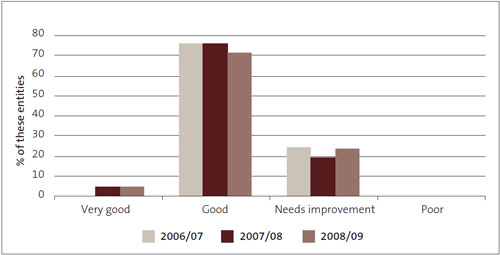
Figure 24:
Financial information systems and controls

Key areas of audit focus in the 2008/09 annual audits
6.31
Two key areas of focus for the audits of DHBs in 2008/09 were:
- procurement policies and practice; and
- non-financial performance reporting.
Procurement policies and practice
6.32
Procurement is an activity that is critical to the effectiveness and efficiency of public entities. It covers all the business processes associated with purchasing and contract management, from policies through to practice. As part of the annual audit for 2008/09, we asked our auditors to:
- follow up on the extent to which any deficiencies and recommendations from the 2007/08 annual audit of procurement policies and practice had been addressed, including a review of a sample of significant procurement decisions of the DHB; and
- check for any other issues that the DHB needed to address to comply with good public sector practice.
6.33
During 2008/09, we also completed an in-depth performance audit of three DHBs' procurement policies and practices. This in-depth review, and other inquiry work, complemented the results of our annual audit work on procurement, and will be reported separately to Parliament.
6.34
In summary, our annual audit work found:
- negligible improvement since last year in the quality of DHBs' procurement policies. Many DHBs are still working on the recommendations arising from our audits for the year ended 30 June 2008, and there are still six DHBs that are deficient in all of the nine aspects of procurement policy that we examined; and
- an increase in deficiencies in procurement practices within DHBs since last year, though this may be largely because we assessed procurement practices based on our own audit, rather than based on a review of DHB self-assessments as we did in 2007/08. Eight DHBs had deficiencies in all six key procurement practice aspects. This is a significant increase from the one DHB in 2007/08 that had deficiencies in all aspects.
6.35
Our 2008/09 audit results are set out in more detail below.
Improving procurement policies
6.36
In the 2008/09 audit, we examined whether DHBs had addressed earlier deficiencies in nine key aspects of procurement policy.8
6.37
While there has been a slight improvement in some DHBs, in many DHBs issues remain from the 2007/08 audit recommendations. In 2008/09, six of the DHBs were deficient in all nine aspects, with 11 DHBs deficient in seven or more of the nine (see Figure 25). Figure 26 sets out which of the nine key aspects DHBs were deficient in.
Figure 25:
Number of deficient aspects of procurement policy
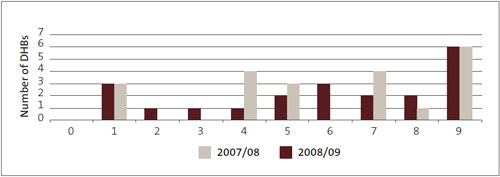
Figure 26:
Number of district health boards with procurement policy deficiencies, by aspect
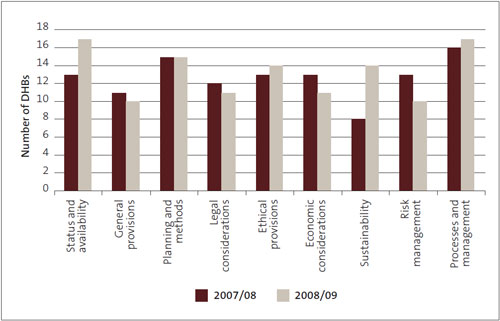
6.38
Deficiencies in procurement policies occurred in all nine aspects, as in 2007/08, with most in processes and management, status and availability, planning and methods, sustainability, and ethical provisions. There were notably fewer DHBs with deficiencies in risk management than there were in 2007/08. But there was a notable increase in the number of DHBs with deficiencies in status and availability, and in sustainability.
6.39
In particular, better guidance is needed in the DHBs' policies about:
- when to tender and timing of tenders;
- dealing with late tenders;
- risk management processes;
- managing fraud and corruption risks;
- dealing with gifts and hospitality when they are associated with procurement;
- managing the risk of potentially unfair advantage when former employees seek to be contractors;
- management of intellectual property considerations;
- obtaining value for money;
- ensuring that the management of contracts is appropriate; and
- sufficiency of documentation.
Improving procurement practice
6.40
In 2007/08, we reported on the deficiencies in DHBs' procurement practice, based on a survey that the DHBs completed (that is, by reviewing the DHBs' self-assessments). In the 2008/09 audit, we examined whether DHBs had addressed their earlier deficiencies in the six aspects of procurement practice by auditing a sample of their contracts.9
6.41
Fourteen of the 21 DHBs are deficient in five or more of the six aspects of procurement practice in 2008/09, compared with five DHBs in 2007/08. Figure 27 shows the number of deficient aspects of procurement practice, by the number of DHBs.
Figure 27:
Number of deficient aspects of procurement practice
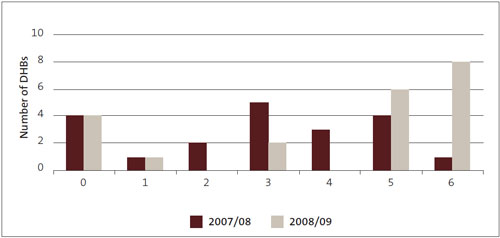
6.42
Probably because we audited procurement practices this year (last year we reviewed the self-assessment returns by the DHBs), we have found a greater number of deficiencies than in 2007/08.10 However, the issues were similar to those reported last year.
6.43
Figure 28 sets out which of the six aspects of procurement practice the 21 DHBs were deficient in. All of the six aspects of procurement practice needed to improve, with no fewer than ten DHBs deficient in any particular aspect, and 16 DHBs deficient in procurement processes. DHBs had more deficiencies in all aspects except management arrangements, compared with 2007/08.
Figure 28:
Number of district health boards with deficiencies in procurement practice, by aspect
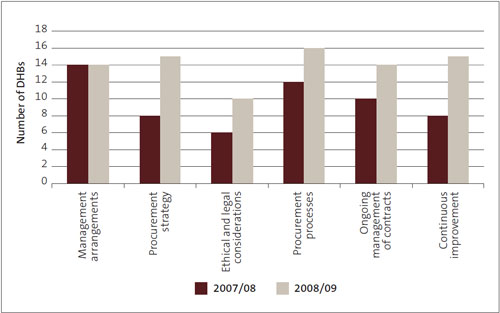
Procurement policies and practices, in summary
6.44
Overall, we note a negligible improvement in procurement policies in the DHB sector since our 2007/08 audit. The risk management policy component has improved. There is room for further improvement in every aspect.
6.45
We continue to be concerned about the number of deficiencies in all aspects of DHB procurement practices. Auditors have raised specific concerns with each DHB's management and Board, and we have reported the concerns to the Minister and the Health Committee in the context of reporting the results of the 2008/09 audit.
6.46
We are aware that there are likely to be changes in procurement frameworks in the health sector, with the creation of a national shared service agency. In our view, whatever the procurement framework, there are issues to be addressed.
6.47
We are, therefore, publishing a report on our audit findings on the purchasing practices of DHBs, and are discussing our findings with the Ministry, District Health Boards of New Zealand (DHBNZ), and other sector groups. We will also be writing, in consultation with the sector, a report on contract management practices, based on our audit findings, and on shared experience of good contract management practices within the sector. We will continue to monitor the DHBs' progress.
Non-financial performance reporting
6.48
In the 2008/09 audit of DHBs, we reviewed the 2009–2012 Statements of Intent. For the first time, we also graded the service performance reports, based on our review of the 2009–2012 Statements of Intent and supporting systems and controls, and the audit of the 2008/09 Statements of Service Performance.
6.49
We reached the view that the 2009–2012 Statements of Intent of DHBs are not yet as well developed as similar accountability documents in other parts of the public sector. As a consequence, we have ranked all DHB Statements of Intent at the lower end of the assessment scale, with a grade of "poor/needs improvement".
6.50
We acknowledge the extensive work that the sector is doing on accountability documents and the accountability framework. We have reported in detail on DHB non-financial reporting in Part 7 of this report.
1: The Estimates of Appropriations 2008/09, B.5, page 152.
2: See section 38, New Zealand Public Health and Disability Act 2000.
3: See www.beehive.govt.nz/release/ministerial+review+group+report+released.
4: The expert advisory board provides the Minister of Health and the Director-General with independent expert advice, and is supported by National Health Board Business Unit staff.
5: The National Health Board Business Unit is a "branded business unit" within the Ministry of Health, with its own organisational structure, and a clearly defined separate identity (like MEDSAFE, Biosecurity New Zealand (in the Ministry of Agriculture and Forestry), and Work and Income (in the Ministry of Social Development)).
6: Briefly stated, standard monitoring is used when a DHB is in a sound financial position, has accountability arrangements in place, and is complying with requirements in a timely manner. DHBs are under a performance watch regime when there is some non-compliance or deterioration against the performance watch requirements. There is intensive monitoring if there is continuing non-compliance and/or deterioration, or a single event creates a material risk. There are two further intervention stages in addition to intensive monitoring – intermediate governance action, and direct governance action if the Minister is seriously dissatisfied with the Board's performance.
7: See section 30 of the New Zealand Public Health and Disability Act 2000.
8: The nine aspects of procurement policy that we examined were:
- whether the policies cover all the DHBs' procurement activities, who approved the policies, and whether they are available to the relevant staff (that is, status and availability);
- general provisions (for example, whether they reflect the essential principles set out in our guidance);
- planning and methods (for example, whether they include an appropriate range of procurement approaches);
- legal considerations (for example, whether they reflect public law obligations and caution about process-related contract obligations);
- ethical provisions (for example, whether they deal with conflicts of interest);
- economic considerations (for example, requirements to ensure value for money);
- whether they take sustainability into account;
- risk management (for example, whether they include provisions for identifying, recording, assessing, and managing risks); and
- processes and management (for example, whether open tendering is required for conventional procurement).
9: The six aspects of procurement practice that we surveyed were:
- management arrangements (for example, structure of procurement management, staff capacity for procurement, management of contract information);
- procurement strategy (for example, strategic planning, selecting a procurement approach to suit the particular circumstances);
- ethical and legal considerations (for example, managing conflicts of interest);
- procurement processes (for example, whether open tendering is used where practical and appropriate, how value for money is achieved);
- ongoing management of contracts (for example, approach to monitoring contracts); and
- continuous improvement (for example, recent improvements, having established some priorities for future improvement).
10: We will consider the implications of the difference for our future audit work.
page top